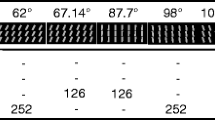Abstract
Visual evoked potentials (EP) were recorded when the test subjects accomplished the tasks of a comparison of a current stimulus with the previous one, the stimuli being presented in a continuous sequence. In the first task, rare repetition of two stimuli (Russian letters) in the continuously changing flow of stimuli was relevant, and the test subject had to press the button when it happened; in the second task, the relevant stimulus was a rare change in the flow of stimuli. The influence of the stimulus repetition/change factor on EP was analyzed. The processes related to the comparison of the current and previous stimuli were most manifest in four time intervals: 120–140, 180–210, 260–280, and 350–370 ms. The occipito-temporal component of EP revealed in the interval of 180–210 ms, which we denoted as the negative component of visual mismatch (NCVM), proved a special component, differing in its functional and temporal characteristics from theN 2b component. WhereasN 2b is modulated by the factor of stimulus probability, the NCVM by that of stimulus repetition/change.
Similar content being viewed by others
References
Anokhin, P.K.,Biologiya i neirofiziologiya uslovnogo refleksa (Biology and Neurophysiology of a Conditioned Reflex), Moscow: Nauka, 1968.
Sokolov, E.N.,Neironnye mekhanizmy pamyati i obucheniya (Neuronic Mechanisms of Memory and Teaching), Moscow: Nauka, 1981.
Naatanen, R., The Role of Attention in Auditory Information Processing as Revealed by Event-related Potentials and Other Brain Measures of Cognitive Function,Behav. Brain Sci., 1990, vol. 13, p. 201.
Bogomolova, I.V. and Farber, D.A., Electrophysiological Analysis of Visual Perceptive Memory. 1. The Influence of the Value of the Interval between the Compared Letters on the SSP Parameters,Fiziol. Chel., 1995, vol. 21, no. 4, p. 13.
Kutas, M. and Hillyard, S.A., An Electrophysiogical Probe of Incidental Semantic Associations,J. Cognit. Neurosci., 1989, vol. 1, p. 38.
Naatanen, R. and Picton, T.W., N2 and Automatic versus Controlled Processes, inCerebal Psychophysiology: Studies in ERP (EEG Suppl., 38), 1986, p. 169.
Naatanen, R.,Attention and Brain Function, Hillsdale (NJ): Hove & London Lawrence Erlbaum Ass. Publ., 1992.
Begleiter, H., Porjesz, B., and Wang, W., A Neurophysiological Correlate of Visual Short-term Memory in Humans,EEG Clin. Neurophysiol., 1993, vol. 87, p. 46.
Zhang, X., Begleiter, H., and Porjesz, B., Reflection of Working Memory: ERP Mnemonic Effects,EEG Clin. Neurophysiol., 1997, vol. 104, p. 546.
Czigler, I. and Csirba, G., Event-related Potentials in a Visual Discrimination Task: Negative Waves Related to Detection and Attention,Psychophysiology, 1990, vol. 27, p. 669.
Czigler, I. and Csibra, G., Event-related Potentials and the Identification of Deviant Visual Stimuli,Psychophysiology, 1992, vol. 29, p. 471.
Nechaev, V.B., The ERP-Correlates of Matching Processes in Visual Modality, inPhysiological and Biochemical Basis of Brain Activity. Abstr. Intern. Symp., St. Petersburg, 1994, p. 20.
Deacon, D., Breton, F., Ritter, W., and Vaughan, H.G., Jr., The Relationship between N2 and N400: Scalp Distribution, Stimulus Probability, and Task Relevance,Psychophysiology, 1991, vol. 28, p. 185.
Breton, F., Ritter, W., Simson, R., and Vaughan, H.G., The N2 Component Elicited by Stimulus Matches and Multiple Targets,Biol. Psychol., 1988, vol. 27, p. 23.
Ritter, W. and Ruchkin, D.S., A Review of Event-related Potential Components Discovered in the Context of Studying P3,Ann. N. Y. Acad. Sc., 1992, vol. 658, p. 1.
Harter, M.R. and Aine, C.J., Brain Mechanisms of Visual Selective Attention, inVarieties of Attention, Parasuraman, R. and Davids, D.R., Eds., London: Acad. Press, 1984, p. 293.
Hansen, J.C. and Hillyard, S.A., Endogenous Brain Potentials Associated with Selective Auditory Attention,EEG Clin. Neurophysiol., 1980, vol. 49, p. 277.
Naatanen, R., Processing Negativity: an Evoked Potential Reflection of Selective Attention,Psychol. Bull., 1982, vol. 92, p. 605.
Munte, T., Brack, M., Drootheer, O.,et al., Brain Potentials Reveal the Timing of Face Identity and Expression Judgments,Neurosci. Res., 1998, vol. 30, p. 25.
Author information
Authors and Affiliations
Rights and permissions
About this article
Cite this article
Nechaev, V.B., Klyucharev, V.A., Kropotov, Y.D. et al. Evoked potentials of the cerebral cortex during the comparison of visual stimuli. Hum Physiol 26, 136–141 (2000). https://doi.org/10.1007/BF02760083
Received:
Issue Date:
DOI: https://doi.org/10.1007/BF02760083




